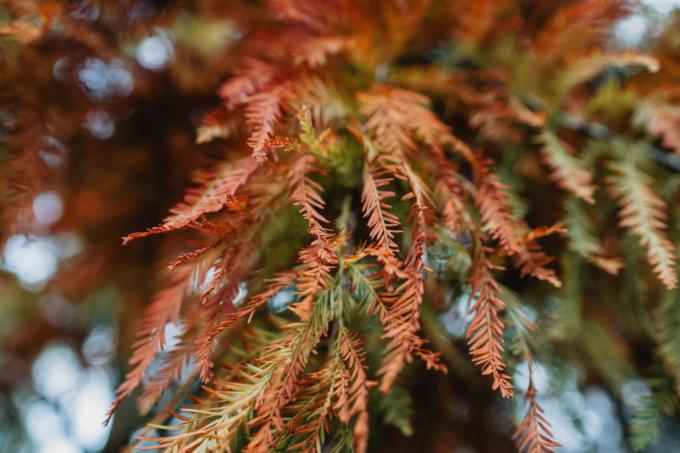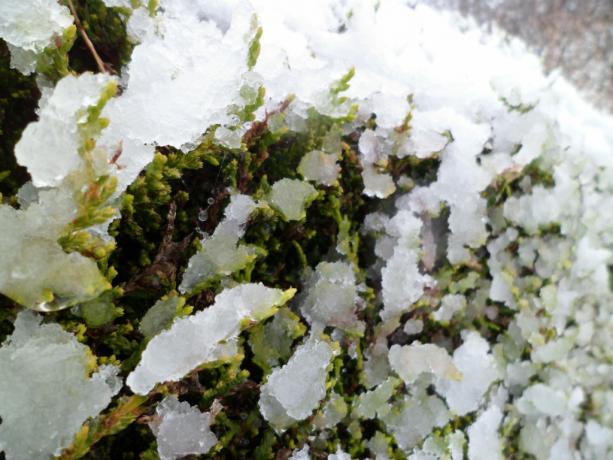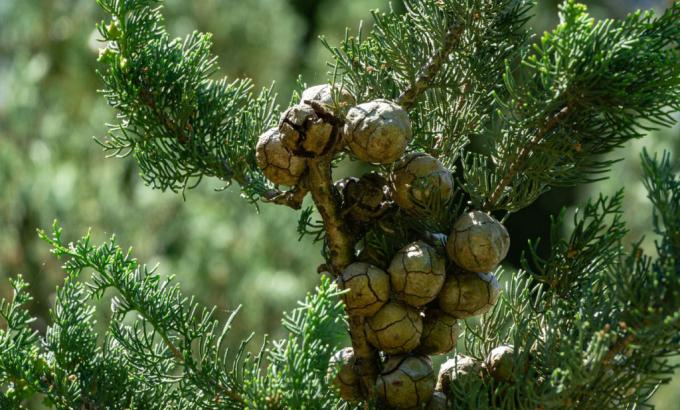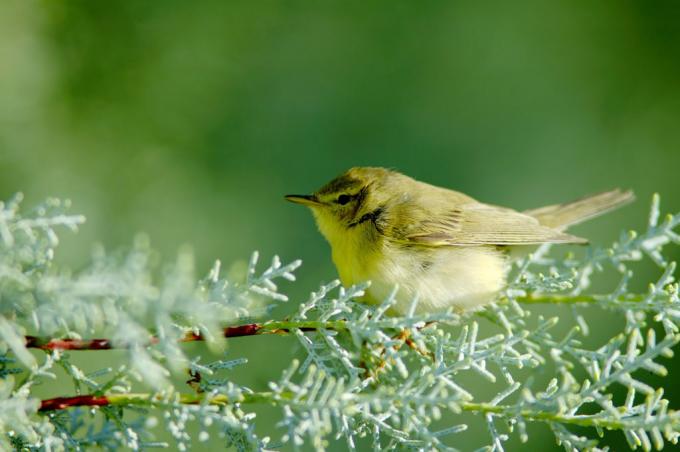Cypresses create a pure holiday mood. Here you will find the best types of cypress and learn what you should consider when planting and caring for Mediterranean plants.

contents
- Cypress: origin and characteristics
- Cypress species and varieties
- Buy cypresses
-
plant cypresses
- The perfect location for cypress trees
- The correct procedure for planting cypress trees
- Plant cypresses in pots
-
care for cypresses
- watering cypresses
- pruning cypresses
- Fertilize cypresses
- cypresses overwinter
- propagate cypresses
- Are cypress trees poisonous?
Cypress: origin and characteristics
The epitome of any Tuscany landscape are the towering cypresses that line streets and paths or set accents between Mediterranean stone houses. But the plants are not only at home here. Cypress species also occur in other warm regions of the northern hemisphere. They can be found especially in Asia, but also in northern Africa and in warm regions of North America. At least twelve million years ago, the plants were even native to today's Germany, but the Ice Age knew how to stop that. In the meantime, however, cypresses are also becoming more common in this country, because many people long for the Mediterranean flair. On top of that, the evergreen conifers provide excellent protection from prying eyes.
Cypress species and varieties
At least 16 cypress species are known worldwide, but only a few of them are cultivated as ornamental plants in Central Europe. Not all species are sufficiently hardy and humidity and precipitation are also limiting factors. Very special types are therefore only rarely found on the market. We present the most common species that can also be kept in this country:
- Mediterranean cypress (Cupressus sempervirens) are probably the best known of all cypresses. It is they who characterize the landscape on the Mediterranean Sea and in Tuscany. Their columnar growth form makes them extremely striking landscape elements. Unfortunately, they are not particularly frost-resistant, as temperatures below -5 °C for a long period of time can cause serious damage.

- Leyland cypress (Cupressocyparis leylandii) are made for beautiful and dense hedges. The robust plant is a hybrid of Nootka cypress (Xanthocyparis nootkatensis) and Monterey cypress (Cupressus macrocarpa). Thus, the Leyland cypress is not a full-flowered cypress in the strict sense, since one of the mother plants is a false cypress (Chamaecyparis) is. But that doesn't matter, because it is wonderfully suited for gardens and grows extremely luxuriantly at up to one meter per year. This species also survives cold winters without any problems. Leyland cypresses are offered in yellow or green. Depending on your taste, you will certainly find the right copy here.
- the cashmere cypress (Cupressus cashmeriana) comes from Bhutan. In Tibet and Nepal it is often planted in front of temples. Its blue-green, scaly leaves hang down from the branches, giving it a beautiful overall look. However, this species is not hardy in our latitudes and is therefore rarely found.
- the Yunnan cypress (Cupressus duclouxiana) comes from the mountain forests of China, where it occurs at altitudes of over 3000 meters. Despite the fact that the species is often used as an ornamental plant in this country, it is only partially hardy, -12 °C is the absolute minimum that the Yunnan cypress can tolerate.

- Monterey cypress (Cupressus macrocarpa) enjoy worldwide popularity. They are common in the gardens of New Zealand and on the American coast, but can also be seen here from time to time. Their frost tolerance is between -6 and -12 °C. In harsh climates, the plants can be tempted into bizarre shapes by strong winds. The cultivar'gold crest' is often referred to as a room or golden cypress because its leaves shine in a rich golden green. It is not hardy, but is an excellent houseplant.
- Incidentally, a reasonable alternative to cypresses is offered by the much more cold-tolerant ones false cypresses (Chamaecyparis). Apart from the slightly flatter leaves, they look confusingly similar to cypresses.
Buy cypresses
Choosing a favorite from the different types is not always easy. Be sure to keep an eye on hardiness and vigour. Because not every species is suitable for a hedge or a topiary. When choosing the individual, there are a few things you should pay attention to when buying. tips for Buying cypresses get here.

plant cypresses
Small cypresses soon develop into true gems. So keeping your distance is the motto when planting the plant. You should therefore keep a distance of at least one meter from your neighbors due to the growth. When planting hedges, of course, sufficient planting distance is required. 50 centimeters should be the minimum here.
In addition to the distances, stability is also of great importance. Mediterranean cypresses (also called columnar cypresses) in particular grow very tall and should therefore be set carefully and firmly.
The perfect location for cypress trees
As residents of warm and sunny places on earth, cypresses prefer a sunny to partially shaded location. You should also attach particular importance to protection from the wind. Most cypress trees are not very hardy, but a sheltered location - near a wall, for example - is good against cold winds. The plants like to stand with their feet in sandy, humus-rich soil, which provides many nutrients but is also permeable to water. A slightly acidic pH value between 5 and 6 is optimal. Our peat-free is ideal for this Plantura organic universal soil. It not only provides your cypress with nutrients, but also promotes healthy soil life.
Unfortunately, even under these conditions, not all regions are suitable for all cypress species. There are few problems with Leyland cypresses, but Mediterranean cypresses in particular should only planted in mild regions such as many places in North Rhine-Westphalia or in wine-growing regions will.
The correct procedure for planting cypress trees
- Only plant young plants from a height of one meter, as they are then much less sensitive to frost
- Cypresses can be planted out between September and May
- Dig a big hole
- Fill the bottom layer with loose excavation; possibly add some sand or gravel to increase the water permeability
- Take the root ball out of the pot and loosen it up a bit with your hand
- Place the root ball in the hole in the ground and fill the hole with excavation
- Press the soil down lightly and water the cypress
- Spreading a layer of bark mulch around the crop helps to prevent the soil from drying out quickly

Plant cypresses in pots
Keeping the plant in a pot is a good alternative when the region is too cold to plant out the much-anticipated cypress. So you can move the plant to a suitable place over the winter. Planting in tubs follows the same principles as planting outdoors. In addition, a layer of gravel is recommended as drainage at the bottom of the pot. It is also very important that the pot is large enough, otherwise columnar cypresses will quickly tip over. A large pot also has the advantage that you have to water a little less, as more water can be stored in the pot.
care for cypresses
The cypresses reward us with the right care with a green foliage all year round. They are not even very demanding when it comes to care. If the location is right, then they really don't need anything else - except maybe a little water on some days and in winter, if necessary, protection from the cold. Most of the trouble is probably caused by the annual pruning. Apart from that, cypresses are extremely relaxed plants for the house and garden. Of course, potted plants always need a little more attention than plants that are planted out.
watering cypresses
Depending on the species, cypresses need sufficient water. Monterey and Yunnan cypress in particular are used to moisture. A layer of bark mulch prevents too much water from evaporating and keeps the soil moist. Outdoor cypresses usually get enough water. Only in dry summers and winters should you try the watering can from time to time.
Of course, cypresses in the winter quarters should not dry out either. Make sure the soil stays slightly moist but not wet.
pruning cypresses
A key feature of cypresses is their vigorous growth. The pruning ensures that the plants remain compact and neither bare nor fall victim to snow breakage. Depending on the species, the versatile plants can even be trimmed as a hedge or skillfully transformed into shapes. A mild day in October is ideal for cutting. How your Cut cypress properly, you can read more about it here.

Fertilize cypresses
In the spring, every cypress will appreciate a generous helping of fertilizer. Whether it's compost, manure or ours Plantura organic universal fertilizer is, in any case, the cypress comes through the year so well. Alternatively, you can of course also use mineral fertilizers and even various home remedies. Everything you need to know about the topic Fertilize cypresses find out here.
cypresses overwinter
Cypress trees originate from the warmer climates of the world. For this reason, not all species are hardy. However, some, such as the Leyland cypress, are sufficiently frost-resistant and survive the winter outdoors without protection. In the case of more sensitive species such as the Monterey cypress and young cypress in general, a light-colored fleece helps against temperatures that are too low. You can use this to wrap the tree when severe night frosts threaten.
Cypresses in buckets must also be protected with bamboo mats or similar to prevent the root ball from freezing. Wrap the mats generously around the pot and place a mat under the pot as well.
If you have a room cypress (Monterey cypress) in your living room, you should move it during the cold months. The plant needs its hibernation and then feels good in a cool place at 5 to 10 °C. However, since it also needs sufficient light in the winter quarters, a cold house or a cool corridor with a window is perfect.
propagate cypresses
Although cypress trees are known for their lush growth, breeding them is a tedious undertaking. They germinate very slowly and the cuttings also take many years to mature for the garden.

- Propagating by seeds: Cypress trees are unisexual, so the plants have male and female flowers. A cone, which carries the seeds, then develops only from fertilized female flowers. But in order for these to be able to germinate, the cone must mature on the plant for several years, but at least two. And then it gets exciting. Since cypress trees come from warm regions with a relatively high risk of forest fires, they have adapted. So that new cypresses can quickly take root after a devastating fire, the cone only opens when it is exposed to great heat. This ensures that numerous seedlings grow immediately after a fire. Now to get to the seeds, you should place the cone on a warm heater until it opens. Sowing takes place in ordinary potting soil. At around 10 °C and a moist substrate, the young plants will develop after a few months. However, it takes many years before they have reached an attractive size.
- Propagation by cuttings: Propagation by cuttings is somewhat faster, although not essential. In the spring, cut a lignified twig about ten centimeters long from the tree. Then break off all the side branches in the lower part of the cutting on the branch. These are the places where the roots will later develop. Now you can stick the cuttings in moist potting soil. A transparent bag pulled over it helps that the soil always stays nice and moist. It is best to take several cuttings at the same time, as often not all of them will turn out well.
Are cypress trees poisonous?
When cutting cypresses, you will be greeted by the spicy scent of cypresses. It is caused by the toxins stored in the plant. Although these have a healing effect in small doses, they are poisonous for humans and animals if consumed. Therefore keep grazing animals or rodents away from the plant. You should also exercise caution with young dogs, because they like to gnaw on everything that gets in their way.

In principle, small children should not be left unattended near a cypress tree. It is best to teach your children early on that cypress trees are poisonous.
